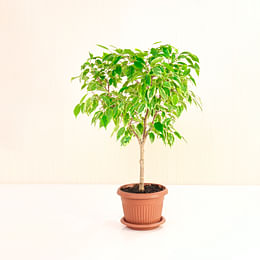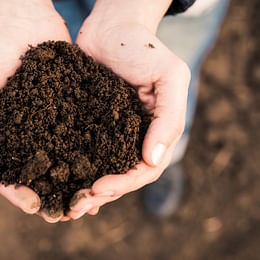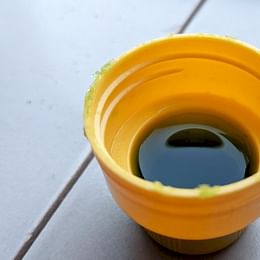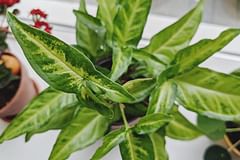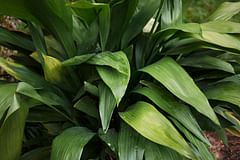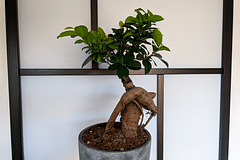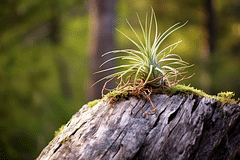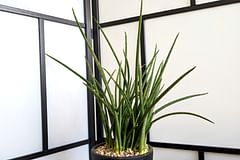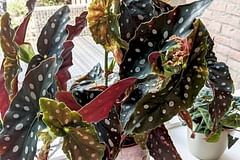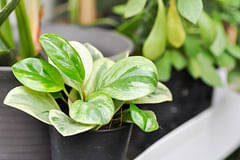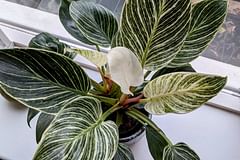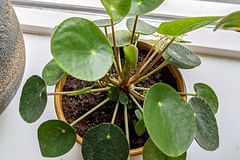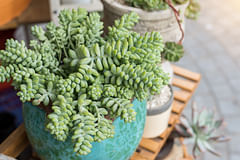How to care for a Weeping Fig (Ficus Benjamina)
New to houseplants? This guide provides beginners with tips on how to care for a Weeping Fig (Ficus Benjamina) and keep it healthy, including information on pruning, propagating, and pest control. Start taking better care of your weeping fig today!
Last updated on:
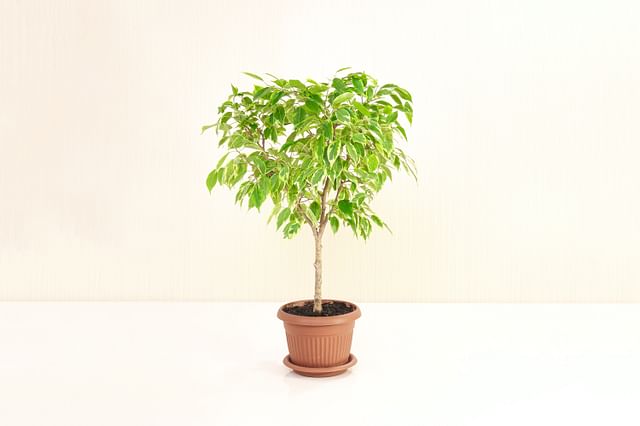 The Ficus Benjamina, more commonly called the weeping fig, is an incredible and low-maintenance houseplant. This tree-like houseplant can reach up to 2.5m (8 ft) in height and has two varieties: variegated leaves and (regular) green leaves. The weeping fig's leaves are slender with a glossy finish, and its small white flowers bloom year-long, although they lack any sort of aroma or scent. The Ficus Benjamina is a great choice for adding a touch of nature and texture to your living spaces and providing natural air filtration throughout your house.
The Ficus Benjamina, more commonly called the weeping fig, is an incredible and low-maintenance houseplant. This tree-like houseplant can reach up to 2.5m (8 ft) in height and has two varieties: variegated leaves and (regular) green leaves. The weeping fig's leaves are slender with a glossy finish, and its small white flowers bloom year-long, although they lack any sort of aroma or scent. The Ficus Benjamina is a great choice for adding a touch of nature and texture to your living spaces and providing natural air filtration throughout your house.
So how do you take care of this amazing-looking plant? That's what we're going to explore in this plant care guide! Disclaimer: I absolutely love this indoor tree, so you won't find me saying a single negative thing about this fantastic houseplant.
These are the topics we're going to cover in this plant care guide:
Let's start learning how to take care of a Ficus Benjamina and keep it healthy in your house throughout the year!
How do you water a Ficus Benjamina?
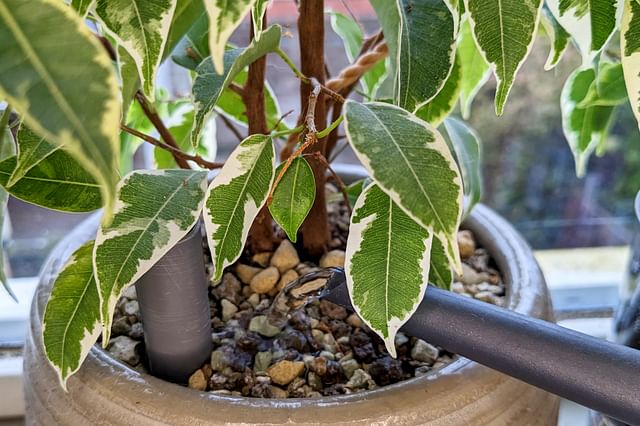
Watering a houseplant is the most important part of taking care of plants. It can help your plant thrive when you do it perfectly, but it can also kill your plant if you keep it dry for too long or water it too often. Luckily, it's quite easy to water your Ficus Benjamina. Here's how you do it!
The Ficus Benjamina is native to Southeast Asia, where it lives in a tropical environment, so it loves moisture! This lets us know how we can keep your weeping fig happy: it's important to make sure the soil is always moist, but not soggy!
You can do this by planting your Ficus Benjamina in a pot with drainage holes. When you water your Weeping fig, water it deeply until you see water coming out of the pot's drainage holes. When you see the water come out of the drainage holes, let it drain for about 5 minutes. Any excess moisture should now have drained from the pot and you've watered your plant perfectly.
How often do you water a Ficus Benjamina?
Take a break between each watering session and let the top 2-5 cm (1-2 inches) of soil dry out. You can check if the soil is dry by sticking your finger a little into the soil. You'll know the top soil is dry when it doesn't stick to your finger very easily. When you regularly check the soil and only water it when the top soil is dry, you'll keep your plant happy, because this will help avoid root rot and overwatering.
So you should water your Ficus Benjamina when the soil is dry, but how often is this? On average, you should water your plant once per week in the spring and summer and once every 14 days in the fall and winter. Be sure to always check if the plant should be watered before you water it, otherwise, you risk overwatering it, which will kill the plant.
Can you use tap water for a Ficus Benjamina?
Not sure if tap water is good for your weeping fig? It depends, but it’s best to use filtered or distilled water! Filtering and distilling the water removes harmful elements so your plant gets the purest hydration. This type of water has a neutral pH level which helps promote growth.
If you're concerned about the cost of filtered or distilled water for your plants, I've got you! There are plenty of affordable ways to filter or cleanse the water without breaking the bank - try a Brita filter or a countertop distiller designed for plants.
Are you all done with watering your weeping fig? Awesome! Now let's learn more about what it takes to keep this plant healthy and happy.
What is the best type of sunlight for a Ficus Benjamina?
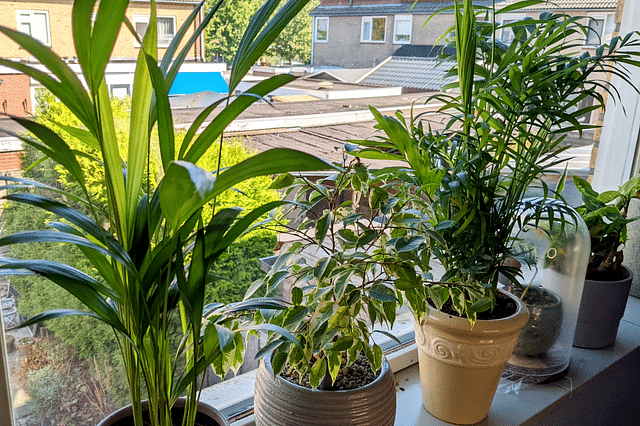
The second most important part of keeping your Ficus Benjamina happy and healthy is giving it the right type of sunlight. A weeping fig needs bright, indirect light to thrive. Place your weeping fig near a window that gets some sun but not too much full sun. This will ensure your weeping fig gets the perfect amount of light and won't get scorched by direct sunlight.
If you don't have access to natural light, you can also use artificial lighting like LED grow lights or fluorescent bulbs to give your plant the right type of light it needs.
Does a weeping fig do well in direct sunlight?
Weeping figs are plants that love to live in warm, tropical environments with indirect light, so they don't like to be exposed to direct sunlight. You'll know if your plant is getting too much direct sunlight because its leaves may start to turn yellow or brown and they will become dried out.
However, a weeping fig does need to get some sunlight so that it can do photosynthesis and stay healthy. To keep your weeping fig flourishing, try finding a spot with bright but indirect light - like near a window that has sheer curtains or blinds.
How much sunlight does a weeping fig need per day?
Your Ficus Benjamina needs 4-6 hours of bright, indirect sunlight per day to thrive. Placing your weeping fig near a south-facing window (if you live in the northern hemisphere) or a north-facing window (if you live in the southern hemisphere) will give it the perfect amount of light.
To keep your weeping fig looking its best and growing healthy, you should rotate it every 3-4 weeks. That way, all sides will get an even amount of sunlight. This will help ensure that the plant doesn't grow lopsided or in an uneven pattern. Doing this regularly will also encourage strong growth for your weeping fig!
By following these simple tips, you can ensure that your weeping fig is getting just the right amount of sunlight each day!
What type of potting soil is best for a weeping fig?
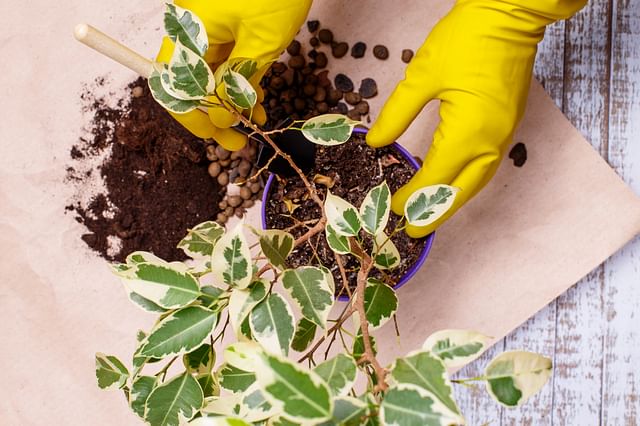
In the section about watering your Ficus Benjamina, we've discovered that the plant loves to be in moist, not wet soil. When you're repotting your Ficus Benjamina, it's important to use soil that helps create the perfect growing environment for your Weeping fig.
You should use a light, well-draining soil mix to help the plant's roots get enough oxygen and prevent them from standing in water for too long. A great mix includes loam, peat moss, perlite or vermiculite, compost or aged manure, and fertilizer for essential nutrients. Make sure the pH levels of your soil are between 6-7 so that the plant can absorb all nutrients!
How often should you repot a weeping fig?
The Ficus Benjamina is quite a fast-growing houseplant, so it'll need to be repotted regularly to have enough space to grow and spread its roots. Ideally, Weeping figs should be repotted once every two years.
It’s best to check the root ball once per year to make sure it still has space to grow in its current pot. That is the best way to find out if you should repot your plant. However, there are a few other great signs your Ficus Benjamina gives you to show that it should be moved to a larger pot!
A clear sign that your Ficus is rootbound is when the soil starts to dry out quickly. If you find yourself watering your weeping fig more often than usual but not seeing any signs of growth, then the roots of your Ficus have likely taken over the entire pot and they absorb the moisture from the soil more quickly.
By keeping an eye on your weeping fig and making sure it has enough space to grow, you'll ensure that it stays happy and healthy!
Should I fertilize my Ficus Benjamina?
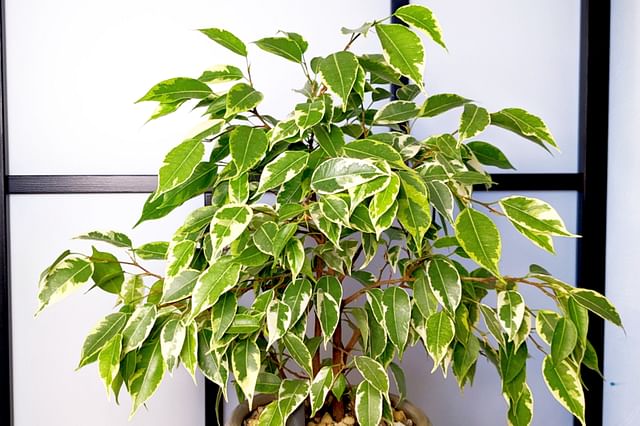
Your Ficus Benjamina loves plenty of indirect sunlight and warmth, but they don't necessarily need a lot of fertilizer or extra nutrients. But sometimes fertilizing your houseplant is a good idea. Especially if your plant is growing slowly or the leaves look dull, yellowish, or wilted, you might need to fertilize your Ficus.
The easiest fertilizer to use for your houseplant is a liquid fertilizer, as you can control how concentrated the fertilizer is by adding more or less to the water you use to water your plant.
How often should I fertilize a Ficus Benjamina?
When you fertilize your Ficus, it's important not to over-fertilize as this can cause harm to the plant. On average, you should fertilize once per month during spring and summer when the plant is actively growing. During autumn and winter, you shouldn't fertilize your Ficus at all, as it won't grow as quickly and won't use the fertilizer.
When you fertilize your Ficus Benjamina, use a fertilizer made just for houseplants. This will make sure that the plant gets all the nutrients it needs and won’t have too much salt in the soil, which can hurt or kill its roots. It's always a good idea to check the specific instructions of your fertilizer, to help you to keep your plant well-fed.
When you fertilize your Weeping fig throughout the growing season, you'll probably see a lot of growth. So much so that you might be wondering if you should or have to prune your plant. Let's find out!
Can I prune my weeping fig?

There are many benefits of pruning a weeping fig (or any houseplant). By pruning your plant, you help to encourage healthy growth by removing dead or diseased branches and leaves. Prune also has an aesthetic benefit: it keeps your plants in shape, making them look better.
When your Ficus starts to grow more quickly during the growing season, you might want to prune your houseplant to help it not only look great but also stay healthy. When you prune your plant, you should use clean, sharp scissors. The best time to prune your Weeping fig is in the late spring or early summer when the weeping fig is actively growing.
After you've pruned a few stems with leaves, you could throw the cuttings away, or you could propagate them and grow new plants! Let's find out how you can propagate the cuttings!
How do I propagate a Ficus Benjamina?
If you want to make your home even more beautiful, try propagating a Ficus Benjamina. This just means cutting off some stems from the existing plant and making sure that they have the right environment and care to grow strong. The best time of the year to propagate your Ficus is during the summer when the plant is actively growing.
The best way to get new Weeping figs is by taking stem cuttings. Look for stems with at least two sets of leaves, then use sharp scissors or pruning shears to make a clean cut below the bottom set of leaves. Place your cuttings in a pot of moist soil and wait for them to root and get used to their new home before planting them in a bigger pot.
After you've planted the cutting in the moist soil, you should make the environment perfect for the cutting to grow more quickly. You should keep your newly planted stem cuttings under bright indirect light and water only when the soil feels dry to the touch but not dried out completely.
Temperature is also very important during the propagation process. You should keep a consistent temperature level between 18-24°C (65-75°F) while waiting for your new plants to root. The higher temperature and humidity help your plants to grow roots more quickly.
What are common pests that affect a Ficus Benjamina?
Like many other houseplants, a Ficus Benjamina also suffers from a few common pests every once in a while. Pests like spider mites, mealybugs, scale insects, and aphids can damage the leaves of a Ficus Benjamina and even stop it from growing properly.
There are a few things you can do to prevent these pests from getting to your plant, like spraying it with an insecticidal soap solution or neem oil. If the pest is already on your plant, you can use insecticidal soap or neem oil to fight the pest. Another great way to fight pests is to get some friendly bugs like ladybugs. These ladybugs love to snack on the pests on your plant and leave your plant itself alone.
Conclusion
Taking care of a weeping fig is easy, but there are some important things to keep in mind. Water the Weeping fig when the top 2-5 cm (1-2 inches) is dry and place your Ficus in a bright spot, without any direct sunlight.
To help your weeping fig stay healthy and grow strong, make sure to fertilize it during the growing season, prune it when necessary using clean scissors or shears, and propagate new plants by taking stem cuttings from an existing plant. If you notice any pests on your weeping fig, you can use insecticidal soap solution or neem oil to fight them off.
With these simple tips for beginners in mind, anyone can take great care of their weeping fig! Share this plant care guide with your friends and family to help them take care of their houseplants as well!
Thank you for reading this post! I hope it helps you to keep your plants healthy and beautiful! If you're looking for more guides on specific plants, you can always request a plant guide to get a guide for the plant you have trouble with.
Tags: beginner-friendly, Plant care tips, tropical
Posted on: Dec 31, 2022